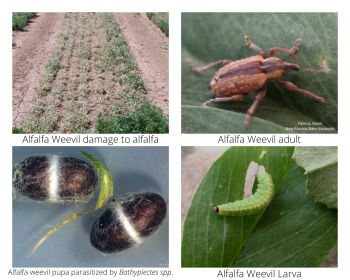Current Research
Finding tools to control worm pests in the face of insect resistance to Bt genes
Virtually all corn and cotton growers in NM grow transgenic Bt varieties to control insect pests. Resistance to multiple Bt genes has been developing in the US including New Mexico. Development of resistance to Bt genes is also being monitored in New Mexico bollworm and budworm populations in commercial fields and research trials. There are no genes in the pipeline to replace those currently available so alternatives for controlling larval pests is an imminent need. In response to this issue we are monitoring the level of resistance to Bt genes and developing alternative tools for controlling bollworm, budworm, and beet armyworm.
Okra-Leaf Cotton
Previous research at Artesia indicated that changes in management can produce a microclimate that is hotter and drier and reduce survival of larval pests by allowing more light and air into the cotton canopy. NMSU and other breeding programs have produced okra-leaf cottons which have a more open canopy which could also produce a microclimate that is less conducive to survival of insect pests. Data collected in 2020-21 indicates there is lower survival in okra-leaf cotton. Why survival is lower is not completely clear. Temperature and relative humidity are not necessarily lower, but higher exposure to direct sunlight could produce higher egg temperatures and lower survival. Trials in 2021 that looked at the impact of radiation suggest that this is part, or most of the reason we are seeing lower survival.
Evaluations of natural control by insect predators in Bt and okra-leaf cottons in 2020 and 2021 indicated control by beneficial predators in okra-leaf cotton is similar to that in the standard canopy cotton. Predation was fortunately not lowered by the open canopy and subsequent changes in canopy microclimate.
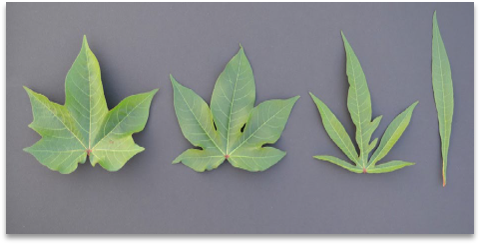
Image of standard, sub-okra /sea-island, okra, and super okra
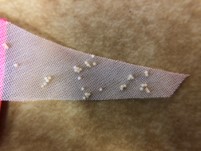
Fabric with sentinel H. zea eggs used in field trials.
Evaluating Resistance to Pyrethroid Insecticides in NM
With increasing incidence of resistance in bollworm and other pests to Bt technologies, cotton producers have been forced to rely upon supplemental insecticide applications often targeting bollworm to prevent excesses economic injury. Pyrethroids are one of the best candidates for managing bollworm in cotton. Pyrethroids have the advantage of being very inexpensive but the disadvantages of being highly disruptive and short lived. Additionally, resistance to pyrethroids is common in many areas. In the nearby High Plains of Texas resistance to pyrethroids has been documented. In 2021 we tested bollworm susceptibility in eastern NM by rearing bollworms in the laboratory from collections of larvae in the field and testing adult moths. Resistance levels were moderate and similar to those in the Texas High Plains which supports the need for additional options for control. Also reductions in insecticide use have numerous positive impacts for growers and the general public. Applicator safety, reduced environmental impacts, and increased biodiversity and conservation of beneficial arthropods are benefits in addition to the more apparent cost savings from reducing inputs.
Enhancing Predation in Cotton to Control Insect Pests
Our research indicates biological control in New Mexico cotton is highly dependent on regular dispersal of predators from hay. Some growers have made adjustments in landscape planning with this in mind. Two trials this year on commercial farms south of Carlsbad supported previous trials at our ASC farm and commercial farms in Artesia indicating that alfalfa hay is important in providing high levels of biological control by predators in cotton and perhaps other row crops.
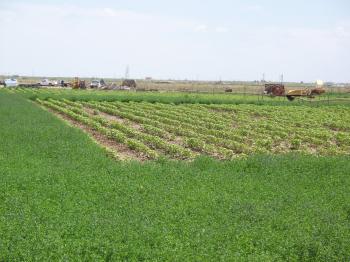
Biological Control of Pecan Insect Pests
Pecan Weevil
Pecan weevil control is a particular concern in urban areas where homeowners have few pecan trees that are not highly managed and where control with insecticides is extremely difficult. Those trees could serve as a source of infestation for commercial orchards.
Biological control of pecan weevil is challenging since the majority of the weevil’s life cycle is in locations that are less accessible to predators, with larvae in the soil and inside the nut for the majority of their life cycle. The stage that is most accessible to the majority of predators is the pecan weevil adult.
However, despite the challenges there is no evidence to suggest that pecan weevil adults aren’t subject to some predation by insect predators. In field trials conducted in commercial pecan orchards since 2012 in Roswell, 7 Rivers, Carlsbad, Hobbs and Lovington, predation rates were generally high, often very high, with over 80% predation in only 48 hours commonly recorded. This was predation of sentinel eggs placed on leaves to mimic pecan nut casebearer eggs, not beetles, but still illustrates the potential for predation.
Key predators were most often green lacewings and ghost spiders. Green lacewings are unlikely to be good predators of pecan weevil but ghost spiders and other predators could potentially provide some control of pecan weevil. An understanding of this predation and techniques to increase or maintain high predation would be very useful particularly in urban environments. Although eradication programs are in place lower populations of pecan weevil in urban trees are difficult to detect so suppression could be helpful.
To begin to determine if there is predation of pecan weevil that could help with control and eradication we placed sentinel beetles, in trees on our farm in Artesia. Because 77% of adults fly to the tree trunk at emergence from the soil, beetles were attached to trunks. Initial trials focused on choosing which species of beetle would work and how to attach them to trees to ensure that this technique would be feasible. We determined that alfalfa weevil would be the best sentinel insect.
Although trials were limited predation was impressive at 45% in just the first three hours. Predation increased to 65% at 24 hours and did not increase beyond that point. At that point the sentinel beetles may have dried to the point where they were unattractive to predators.
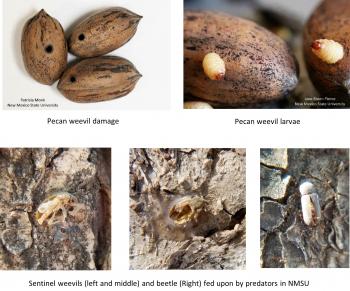
Pecan Budworm New Pest of Pecan in NM
In 2021, we confirmed the presence of pecan budworm in NM. It has likely been here longer as we saw damage typical of pecan budworm in Roswell in 2013. We have an extension publication in progress to inform growers about this new pest.
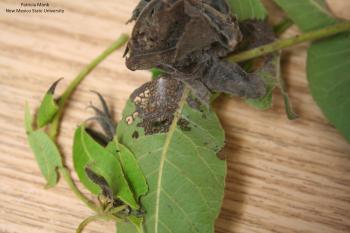
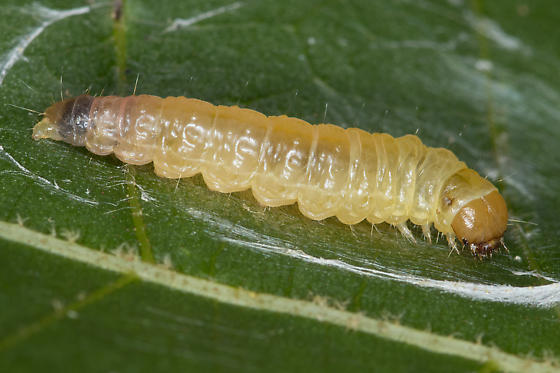
Pecan Budmoth Larva (Photo by George Smiley)
Pecan Nut Casebearer
Pecan nut casebearer is a key pest of pecan in New Mexico. Biological control is a significant factor in suppression and eradication efforts. Trials have been conducted since 2012. With predation levels often over 80% in 48 hours. Sentinel frozen eggs are used to estimate predation in commercial fields. Recent tests indicated maintaining ground cover is a means of enhancing biological control.
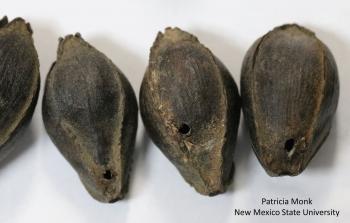
Alfalfa Weevil Biological Control
Alfalfa weevil remains the most significant insect pest of alfalfa, routinely causing losses and necessitating insecticide applications. Periodically losses can be extreme as illustrated. Insecticidal control is becoming increasingly difficult with resistance to a number of insecticides. Some of the most effective insecticides are expensive.
Control of alfalfa weevil with insect parasitoids and predators could save New Mexico growers over $2 million per year. The ASC farm at Artesia has maintained good control of alfalfa weevil with biological control for over 20 years.
Replicating this type of control in just alfalfa, sorghum and pecan could save growers $6.5 million per year in reduced losses and control costs. Recently we acquired an insectovac which will allow us to increase our rearing capacity of the most promising parasitoid to allow us to do more releases and in greater numbers throughout New Mexico.
